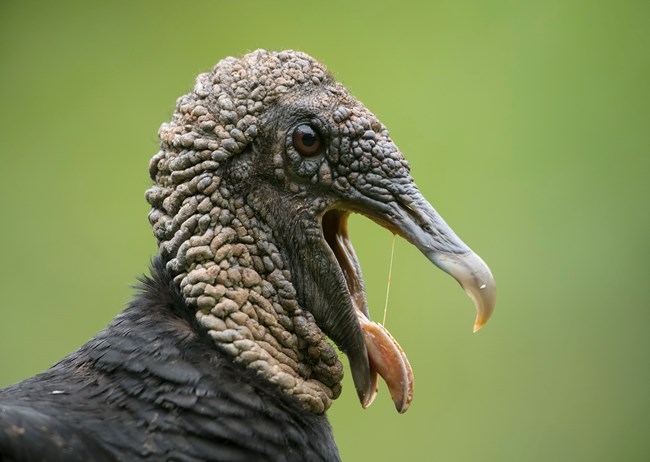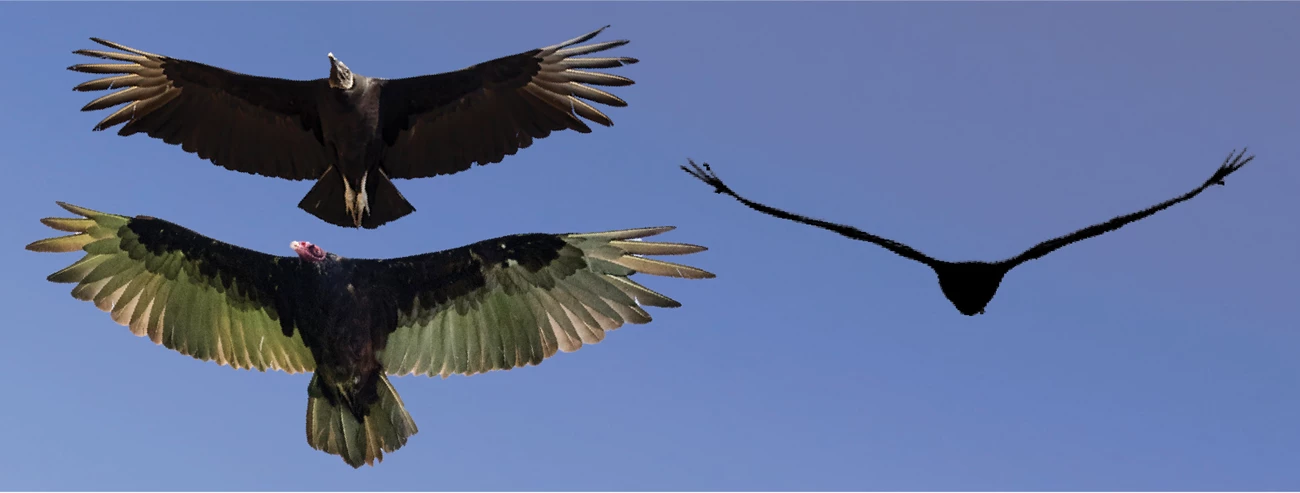Last updated: August 15, 2021
Article
NETN Species Spotlight - Turkey and Black Vultures


Doug Greenberg
I know, right? That ugly mug is unlikely to appear on the cover of Bird Fancy magazine any time soon. But the Black Vulture, along with its close relative the Turkey Vulture, provides the invaluable service of cleaning up our roadsides and forests of dead animal carcasses helping to stop the spread of diseases like rabies. A dirty job if there ever was one, yet these tireless sanitation workers have not even once been profiled by Mike Rowe.
Is it a TV or BV?
Both species occur in the Northeast, though the Turkey Vulture (TV) is more common and has been around a lot longer. Black Vultures (BV) are relative newcomers. Each have recovered nicely in numbers after decades of persecution and DDT use, and BV’s appear to be expanding their range further north each year. These are large birds: TV’s have an expansive 6 foot wingspan, with BV’s coming in at a slightly shorter 5 feet. When in search of a meal, both utilize warm up currents of air to be lifted high in the sky and can be seen swirling together in these “kettles”. They often glide to the next “thermal” with almost effortless efficiency, but BV’s do need to flap their shorter wings more frequently than TV’s.
Why the Long Face?
The heads of both Turkey and Black Vultures lack any feathers. This is an adaptation to allow the birds to more easily keep their heads clean of contamination. No small feat for an animal that makes it’s living poking it’s face into dead animals. Vultures are built for life as a scavenger. Acute eyesight helps the bird spot a potential meal from high up in the sky, perhaps laying eyes on a carcass as small as 3-ft long from as far as 4 miles away. Their powerful bills can make quick work of a tough hide.

Smell ya later
Unusual in the bird world, Turkey Vultures have a very keen sense of smell, able to detect dead animals as fresh as 12 hours old from more than a mile away. Even Vultures have standards though, and won’t typically dine on highly rotted animals. Black Vultures lack a highly developed sense of smell, relying instead on their sharp eyesight and brute force to secure meals. Groups of them sometimes follow Turkey Vultures to a fresh carcass. They then gang-up on the often solitary TV, driving it away from the meal. As a result, in places where there are a lot of BV’s, TV’s may specialize in devouring smaller meals that they can quickly swallow before the BV’s can drive them away.
Anthrax with a Side of Botulism
Even though they like their meals relatively fresh, Vultures sometimes prefer for a little decay to have set in to make it easier to penetrate a carcass. It’s a good thing for them they posses the remarkable ability to metabolize bacteria that would most likely kill other would-be scavengers. Their gut contains special acids that can dissolve anthrax, botulism, salmonella, and cholera bacteria. They may even be utilizing strains related to flesh eating bacteria to help break down their meals more completely.
What is This - a Wake or a Party?
Both, actually. In a somewhat morbid naming convention, when Vultures flock together on their nightly roosts, often in large dead trees, it is known as a “wake of vultures”. Sometimes these roosts can reach several hundred birds. In some parts of the country they are becoming a nuisance and can cause property damage to nearby buildings. Black vultures have even been known to attack and kill young and vulnerable livestock. Powerful laser pointers, blasts of loud sounds and light (pyrotechnic shells know as Screamer Sirens and Bird Bangers), and even the hanging of a dead vulture by its feet are all used to harass and discourage the birds from congregating en masse in some neighborhoods.
Dilophosauric Doppelganger?
Though he took a lot of heat for it at the time, in Jurassic Park Michael Crichton bestowed upon the Dilophosaurus dinosaur the ability to spit acidic venom at its prey or adversaries. There is zero evidence in the fossil record that this, or any dinosaur, possessed this ability, but perhaps Mr. Crichton took inspiration from Black Vultures? In another habit that does less to endear them to most people, BV’s can essentially projectile vomit on demand as a defense mechanism. A trait that almost seemed to all but delight John James Audubon (see quote). Though not venomous, this projectant is acidic and causes a burning sensation to the eyes of whatever creature is unfortunate enough to be on the receiving end.
Even Less A-pee-ling Behavior
If you’re on the fence of Vulture fandom, this next trait isn’t likely to sway you over to their side. Though it seems uncomely to us, when a Vulture starts to get too warm, it will excrete down it’s legs to cool off through an evaporative effect - a practice know as “urohydrosis”. This works in much the same way sweat cools us down on hot days, and since birds lack the ability to sweat or pant - they may as well...
For more information
-Watch a large roost of Black Vultures disperse into a kettle:
- Learn more about NETN’s long-term Breeding Landbird monitoring program.
Download a printable PDf of this article.
Tags
- acadia national park
- appalachian national scenic trail
- eleanor roosevelt national historic site
- home of franklin d roosevelt national historic site
- marsh - billings - rockefeller national historical park
- minute man national historical park
- morristown national historical park
- saint-gaudens national historical park
- salem maritime national historical park
- saratoga national historical park
- saugus iron works national historic site
- vanderbilt mansion national historic site
- weir farm national historical park
- species spotlight
- netn
- bird
- birding
- turkey vulture
- black vulture
- inventory and monitoring division
